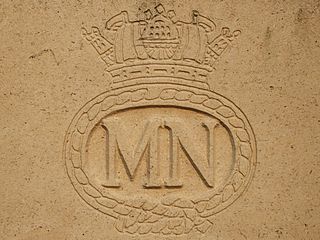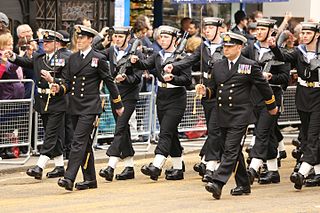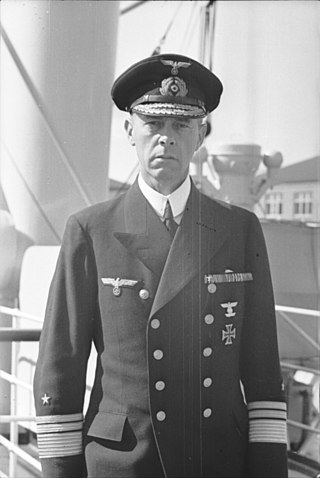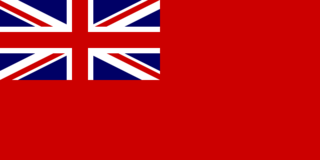 |
| Merchant Navy of the United Kingdom |
|---|
| Components |
| History |
| Ships |
| Personnel |

The following equivalent ratings in the Merchant Navy were those officially recognised by the National Maritime Board for British Merchant Navy ocean-going cargo vessels carrying up to six passengers in 1919, 1943, and 1964. They are listed in ascending order of seniority.
"Mixed" crew refers to crews that consisted of both white and non-white (African or Asian) members, as was common on British-registered ships, which often had white officers and (sometimes) petty officers, and non-white crew. These tables would probably only have related to white ratings. However, for these purposes, non-white ratings of European, American, or West Indian origin would probably have been considered "white".
The Merchant Navy Ratings Pension Fund (MNRPF) defined benefits scheme was set up in 1978 to provide pensions for retired Merchant Navy ratings. [1] [2]
| Deck Department | Engine Room Department | Catering Department |
|---|---|---|
| 1919 [3] | ||
| Deckboy | Boy | |
| Ordinary Seaman | ||
| Assistant Cook (21-59 white crew or 26-74 mixed crew) Assistant Steward (21-59 white crew or 26-74 mixed crew) | ||
| Messroom Steward (up to 59 white crew or 74 mixed crew) | ||
| Assistant Cook (60-89 white crew or 75-112 mixed crew) Assistant Steward (60+ white crew or 75+ mixed crew) Messroom Steward (60+ white crew or 75+ mixed crew) Saloon Steward (60-89 white crew or 75-112 mixed crew) Second Steward (21-59 white crew or 26-74 mixed crew) | ||
| Assistant Baker (90+ white crew or 113+ mixed crew) Assistant Cook (90+ white crew or 113+ mixed crew) Second Cook (21-89 white crew or 26-112 mixed crew) Second Steward (no Storekeeper carried; 60-89 white crew or 75-112 mixed crew) | ||
| Able Seaman | Trimmer | Second Cook & Baker (60-89 white crew or 75-112 mixed crew) Storekeeper (60-89 white crew or 75-112 mixed crew) |
| Boatswain's Mate Lamptrimmer Painter Quartermaster Deck Storekeeper | Fireman | Baker (60-89 white crew or 75-112 mixed crew) Butcher (60-89 white crew or 75-112 mixed crew) Pantryman (90+ white crew or 113+ mixed crew) Second Cook & Baker (90+ white crew or 113+ mixed crew) Second Steward (Storekeeper carried; 60-89 white crew or 75-112 mixed crew) Storekeeper (90+ white crew or 113+ mixed crew) |
| Launchman Water Tender | Assistant Engine Room Storekeeper Greaser Leading Fireman | Second Cook (90+ white crew or 113+ mixed crew) |
| Boatswain Boatswain's Mate (large steamer) Carpenter's Mate & Joiner (up to 10,000 tons) Pumpman (oil tanker) Sailmaker | Diesel Engine Greaser Donkeyman Electrical Greaser Engine Room Storekeeper First Leading Fireman Refrigerator Greaser Tunnel Greaser | Baker (90+ white crew or 113+ mixed crew) Butcher (90+ white crew or 113+ mixed crew) Cook (up to 20 white crew or 25 mixed crew) Ship's Cook (60-89 white crew or 75-112 mixed crew) |
| Carpenter (up to 8,000 tons) Carpenter's Mate & Joiner (10,001-25,000 tons) | Second Steward (90+ white crew or 113+ mixed crew) Ship's Cook (90+ white crew or 113+ mixed crew) | |
| Boatswain (large steamer) Carpenter (8,001-10,000 tons) | Cook (21-59 white crew or 26-74 mixed crew) Cook-Steward (up to 20 white crew or 25 mixed crew) Steward (up to 20 white crew or 25 mixed crew) | |
| Carpenter (10,001-12,000 tons) | Chief Steward (21-59 white crew or 26-74 mixed crew) Cook (60-89 white crew or 75-112 mixed crew) | |
| Carpenter (12,001-25,000 tons) | Chief Cook (90+ white crew or 113+ mixed crew) Chief Steward (60-89 white crew or 75-112 mixed crew) | |
| Carpenter (over 25,000 tons) | Chief Steward (90+ white crew or 113+ mixed crew) | |
| 1943 [4] | ||
| Ordinary Seaman | ||
| Messroom Steward Assistant Steward/Stewardess Saloon Steward Assistant Cook (21-59 white crew or 26-74 mixed crew) | ||
| Second Cook (21-89 white crew or 26-112 mixed crew) Assistant Cook (60+ white crew or 75+ mixed crew) Assistant Baker Assistant Butcher | ||
| Able Seaman | Fireman Steward Trimmer | Second Steward (60-89 white crew or 75-112 mixed crew; no storekeeper carried) Storekeeper (60-89 white crew or 75-112 mixed crew) Second Cook and Baker (60-89 white crew or 75-112 mixed crew) |
| Lamp Trimmer Painter Quartermaster Deck Storekeeper | Fireman | Second Steward (60-89 white crew or 75-112 mixed crew; storekeeper also carried) Pantryman Storekeeper (90+ white crew or 113+ mixed crew) Second Cook (90+ white crew or 113+ mixed crew) Baker (60-89 white crew or 75-112 mixed crew) Butcher (60-89 white crew or 75-112 mixed crew) |
| Boatswain's Mate (up to 12,000 tons) Launchman Water Tender | Leading Fireman Greaser Assistant Engine-room Storekeeper | Second Cook and Baker (90+ white crew or 113+ mixed crew) |
| Boatswain's Mate (over 12,000 tons) Pumpman Sailmaker | Engine-room Storekeeper | Ship's Cook (21-89 white crew or 26-112 mixed crew; chief cook also carried) Ship's Cook (up to 20 white crew or 25 mixed crew) Baker (90+ white crew or 113+ mixed crew) Butcher (90+ white crew or 113+ mixed crew) |
| Donkeyman | ||
| Boatswain (up to 8,000 tons) | ||
| Carpenter's Mate/Joiner (up to 10,000 tons) | ||
| Boatswain (8,001-10,000 tons) | Second Steward (90+ white crew or 113+ mixed crew) Ship's Cook (90+ white crew or 113+ mixed crew; chief cook also carried) | |
| Carpenter (up to 8,000 tons) Carpenter's Mate/Joiner (10,001-25,000 tons) | ||
| Cook-Steward (up to 20 white crew or 25 mixed crew) Ship's Cook (21-59 white crew or 26-74 mixed crew; no other cook carried) Chief Cook (21-59 white crew or 26-74 mixed crew; another cook carried) | ||
| Boatswain (10,001-12,000 tons) | ||
| Boatswain (over 12,000 tons) Carpenter (8,001-10,000 tons) Carpenter's Mate/Joiner (over 25,000 tons) | ||
| Chief Cook (60-89 white crew or 75-112 mixed crew) Steward (up to 20 white crew or 25 mixed crew) | ||
| Carpenter (10,001-12,000 tons) | ||
| Chief Steward (21-59 white crew or 26-74 mixed crew) | ||
| Carpenter (12,001-25,000 tons) | ||
| Chief Steward (60-89 white crew or 75-112 mixed crew) | ||
| Carpenter (over 25,000 tons) | ||
| Chief Steward (90+ white crew or 113+ mixed crew) | ||
| 1964 [5] | ||
| Deck Boy | Engine Room Boy | |
| Catering Boy | ||
| Junior Ordinary Seaman | Junior Ordinary Engine Room Rating | |
| Senior Ordinary Seaman | Senior Ordinary Engine Room Rating | |
| Deck Hand (Uncertificated) | ||
| Assistant Steward Messroom Steward Saloon Steward Stewardess | ||
| Assistant Baker Assistant Butcher Assistant Cook Second Cook (21-59 white crew or 26-74 mixed crew) | ||
| Able Seaman Efficient Deck Hand | Cleaner & Wiper Fireman Steward Trimmer | |
| Lamp Trimmer Painter Quarter Master (up to 12,000 tons) Deck Storekeeper | Engine Room Hand Fireman | Baker or Second Cook and Baker (21-59 white crew or 26-74 mixed crew) Pantryman Second Cook (60+ white crew or 75+ mixed crew) Second Steward (21-59 white crew or 26-74 mixed crew) Catering Storekeeper |
| Launchman Quarter Master (over 12,000 tons) Water Tender | Assistant Engine Room Storekeeper Greaser Leading Fireman | |
| Boatswain's Mate (up to 12,000 tons) | ||
| Boatswain's Mate (over 12,000 tons) Pumpman (oil tanker) | Donkeyman Engine Room Storekeeper (up to 12,000 tons) | Baker or Second Cook and Baker (60+ white crew or 75+ mixed crew) Butcher |
| Assistant Carpenter & Joiner (up to 10,000 tons) Boatswain (up to 8,000 tons) | Engineer Assistant | |
| Engine Room Storekeeper (over 12,000 tons) | ||
| Ship's Cook (up to 20 white crew or up to 25 mixed crew) | ||
| Assistant Carpenter & Joiner (10,001-25,000 tons) Boatswain (8,001-10,000 tons) | Second Steward (60+ white crew or 75+ mixed crew) Ship's Cook (21-59 white crew or 26-74 mixed crew; Chief Cook carried) | |
| Carpenter (up to 8,000 tons) | Ship's Cook (60+ white crew or 75+ mixed crew; Chief Cook carried) | |
| Assistant Carpenter & Joiner (over 25,000 tons) Boatswain (10,001-12,000 tons) | ||
| Carpenter (8,001-10,000 tons) | Chief Cook (21-59 white crew or 26-74 mixed crew) Cook Steward Ship's Cook (21-59 white crew or 26-74 mixed crew; no Chief Cook carried) | |
| Boatswain (12,001-25,000 tons) | ||
| Carpenter (10,001-12,000 tons) | ||
| Boatswain (over 25,000 tons) | Chief Cook (60+ white crew or 75+ mixed crew) | |
| Carpenter (12,001-25,000 tons) | Steward (up to 20 white crew or 25 mixed crew) | |
| Chief (or only) Steward (21-59 white crew or 26-74 mixed crew) | ||
| Carpenter (over 25,000 tons) | ||
| Chief (or only) Steward (60+ white crew or 75+ mixed crew) | ||













